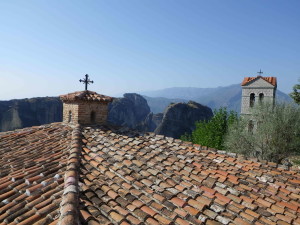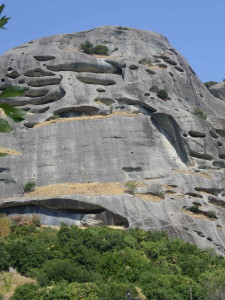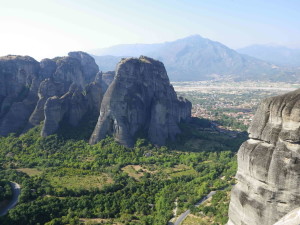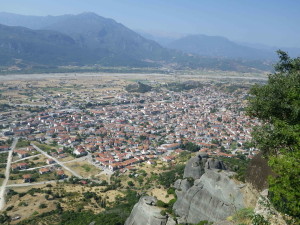By now both the blogs and the mornings begin routinely enough: wake-up call that always seems to be a bit too early and a breakfast that is bigger than we normally consumer. Everyone has maintained both good attitudes and robust appetites!
Today we traveled just a few miles to the beautiful and famous Meteora Monasteries. Christians arrived in this region in AD 800 initially occupying caves at the base of these huge natural spires. As our bus winded its way to our first stop we could easily view the countless “niches” carved out of the side of these mountainous spires where hermits would dwell to separate themselves from society.
“Meteora” is Greek for “suspended in air.” In the 1300s entire monasteries were built atop these cliffs. Originally reached by hinged ladders there are now roads and stairs that provide access. During Meteora’s heyday there were 24 monasteries but now only five remain.
Our first monastery stop was Varlaam, and while our bus was able to get us close to the monastery we still had to take 150 steps to make it to the top. The small church of this monastery was painted from ceiling to floor with 15th century frescoes. Byzantine in style they were all striking in spite of the muted colors that come with age.
In the narthex the scenery was of the martyrdom of the saints. If a person was not baptized that person could go no further. On one level it was a bit ghoulish, with scenes of all kinds of ways a Christian could have been tormented and killed for his or her beliefs. I was thinking about how much energy I spend trying to convince others that you ought to go to our church and choose our beliefs, etc. Here a potential convert first had to reflect on what it may cost you to choose to be a follower of Christ.
Our second stop was a nunnery called St. Stephen, and while it was neat and tidy and very picturesque, the frescoes were new (replacing their older ones) – about fifteen years old. Since they too were painted in the Byzantine tradition, it gave you a good idea of how the early frescoes most have looked with its full and brilliant color.
After lunch we then settled in for a long bus ride (over four hours) to Delphi. The scenery made for an enjoyable afternoon, even if we were cooped up in a bus. I had no idea that Greece was primarily mountainous and so if we were not traveling along a plain we were navigating through hairpin curves up and down mountains. Much of the Thessaly Plateau was planted in crops of all kinds including cotton, eggplant, tomato, melons and sunflower. Some fields had already been harrowed over with rich, black clumps of dirt that would make any gardener envious.
We arrived around 6 PM and checked into our hotel just outside of Delphi. Happily, we have comparatively little traveling to do to get to Athens. Much of our day will be spent in Delphi. Our hotel is a block from the Ionia Sea, with turquoise water that would make any beach in America jealous.
Grace and peace and good night!
Greg
Excursus on Monasticism:
The monastic movement began around the third century as Christianity became increasingly established. By its official legalization when Constantine converted in the 4th century it was a full movement.
Early monasticism was a version of renewal that has birthed other renewal movements throughout history including Puritanism in the colonial period and 19th century American revivalism.
Monasticism was a way for followers of Jesus to deal with the big questions of how to live out one’s discipleship authentically.





Recent Comments